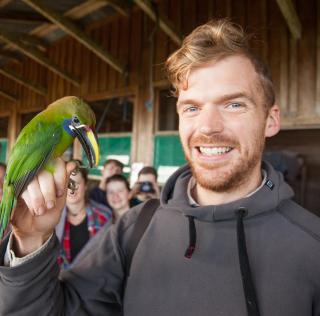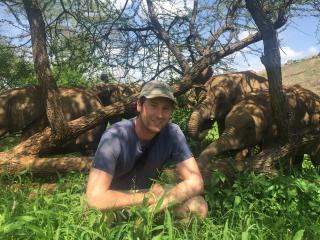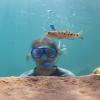Sensors already equip a range of tools to enhance monitoring capacity for conservation. Some of the higher bandwidth technologies, like camera traps and acoustic monitoring systems, have been essential elements of the conservation toolkit for decades, and thus have enough users that we've created dedicated WILDLABS groups to address them. But a whole range of lower bandwidth sensors beyond these core technologies are being increasingly integrated into conservation monitoring systems, and offer rich new insights into the wildlife and ecosystems we're all working to protect. As with many technologies, cost and access have historically been challenges to the adoption of new sensors, but with low-cost and open-source solutions on the rise, we're excited to see what the future of this space holds.
Getting Started with Sensors:
- Watch Shah Selbe's Tech Tutors episode on scaling FieldKit, an open-source conservation sensor toolbox, from a project to a successful conservation tech product.
- Check out our Virtual Meetup about Low-Cost, Open-Source Solutions in conservation tech, including a talk by Alasdair Davies on the Arribada Initiative's work with thermal sensors in early warning systems.
- For a more in-depth introduction, watch the first video in our datalogger mini-series: Freaklabs: How do I get started with Arduino?
In this group, you'll meet others who are using and innovating diverse sensors in their work, discuss ways to make sensors more effective & accessible for conservationists, learn about what sensors are already helping us accomplish in the field, and have the opportunity to ask and answer questions. Join this group to get started!
Header image: Emma Vogel, University of Tromsø
GreenLab


- 0 Resources
- 20 Discussions
- 8 Groups
McMaster University
Developing a hand held genetic tool for real time wildlife detection

- 1 Resources
- 0 Discussions
- 2 Groups
- @MattyD797
- | He/Him
PhD Student | Cornell University | Smithsonian Institution; My focus is in computational ecology within fishery acoustics


- 0 Resources
- 16 Discussions
- 12 Groups
Software engineer working on natural resource management technology.
- 0 Resources
- 0 Discussions
- 6 Groups
As a fresh electrical engineer, I am passionate about leveraging technology for biodiversity monitoring, logging, and poaching detection in tropical regions.
- 0 Resources
- 0 Discussions
- 9 Groups
World Wide Fund for Nature/ World Wildlife Fund (WWF)
- 0 Resources
- 4 Discussions
- 8 Groups
- @ConnieWhiting
- | She/They
University of Cambridge
PhD at Cambridge Zoology, working in Cichlid plasticity and evolution
- 0 Resources
- 2 Discussions
- 3 Groups
- @srfreeze
- | He/Him
I am a wildlife expert with a decade of experience working with bats and proven success in efforts to study, manage, and conserve the species. I work at the nexus of advanced technologies and deep ecological understandings to provide effective solutions to government, academic, a
- 0 Resources
- 0 Discussions
- 11 Groups
- 0 Resources
- 0 Discussions
- 7 Groups
My research focuses on using Next-Generation Sequencing (NGS) to study endangered species, including carnivores, chiropterans (bats), and lizards, as well as their microbiomes.
- 1 Resources
- 3 Discussions
- 20 Groups
A chemist by training and enthusiast about the environment by nature. Currently finishing my PhD where I was lucky to merge several of my passions such as programming, data analysis, aquatic ecology and analytical chemistry.
- 0 Resources
- 0 Discussions
- 7 Groups
- @limburan
- | she/her
Bat Conservation Trust
Research Scientist at Bat Conservation Trust
- 0 Resources
- 0 Discussions
- 10 Groups
PhD position available at the University of Konstanz in the Active Sensing Collective Group!
28 March 2025
We are hiring for a customer support / marketing specialist.
20 February 2025
Osa Conservation is launching our inaugural cohort of the ‘Susan Wojcicki Research Fellowship’ for 2025, worth up to $15,000 per awardee (award value dependent on project length and number of awards given each year)....
10 February 2025
New paper - "acoupi integrates audio recording, AI-based data processing, data management, and real-time wireless messaging into a unified and configurable framework. We demonstrate the flexibility of acoupi by...
7 February 2025
The Conservation Technology Laboratory within the Population Sustainability department is seeking two fellows for summer 2025
5 February 2025
Conservationists use tools like drones, satellites, and camera traps to monitor ecosystems and scale their impact. But new challenges like transparency, funding gaps, and engagement remain. Web 3.0 technologies offer...
28 January 2025
The worst thing a new conservation technology can do is become another maintenance burden on already stretched field teams. This meant Instant Detect 2.0 had to work perfectly from day 1. In this update, Sam Seccombe...
28 January 2025
The Zoological Society of London's Instant Detect 2.0 is the world's first affordable satellite connected camera trap system designed by conservationists, for conservationists. In this update, Sam Seccombe describes the...
21 January 2025
Over the years, a large number of developments have gone up in the area that I live in and the municipality is not doing what they should when it comes to upholding the laws that have been put in place to protect the...
20 January 2025
The Marine Innovation Lab for Leading-edge Oceanography develops hardware and software to expand the ocean observing network and for the sustainable management of natural resources. For Fall 2025, we are actively...
6 October 2024
Join the team at FieldKit, an open-source software and hardware sensor platform, and help us validate the quality and usability of the FieldKit platform.
25 September 2024
September 2024
event
16 Products
Recently updated products
117 Products
1 R&D Projects
81 Organisations
Recently updated products
Recently updated R&D Projects
Recently updated organisations
| Description | Activity | Replies | Groups | Updated |
|---|---|---|---|---|
| Thanks Phil - I have e-mailed you.Peter |
|
Animal Movement, Sensors | 3 weeks ago | |
| One of our goals with explorer.land is to bridge satellite data and on-the-ground perspectives — helping teams combine field updates,... |
|
AI for Conservation, Geospatial, Open Source Solutions, Sensors | 1 month ago | |
| True, the US ecosystem is a challenging space right now, for basically all sectors. We should not let the US chaos prevent us from engaging with opportunities in other... |
|
AI for Conservation, Camera Traps, Connectivity, Drones, Emerging Tech, Ethics of Conservation Tech, Marine Conservation, Sensors | 1 month ago | |
| Hi WILDLABS Community,I’m Simon Juma from Kenya, working on a project to track and manage Red-billed Quelea birds, which... |
|
AI for Conservation, Sensors | 2 months ago | |
| Thank you! I will follow up by email. |
+8
|
Animal Movement, Conservation Dogs, East Africa Community, Geospatial, Sensors, Women in Conservation Tech Programme (WiCT) | 2 months 1 week ago | |
| Thanks Jack, that's an interesting repo. |
|
Sensors | 2 months 2 weeks ago | |
| Sure, Akio! Happy to answer!1. Yes, something like that. The few existing i guess applied already for GPS collar (literally collar) that usually for big cats and some other big... |
|
Sensors, Animal Movement, Open Source Solutions | 2 months 2 weeks ago | |
| How much does it cost to incorporate machine learning into your conservation drone geospatial analysis? How does it speed up your workflow... |
|
Conservation Tech Training and Education, Drones, Geospatial, Open Source Solutions, Sensors, Software Development | 2 months 3 weeks ago | |
| Thanks so much for all the advice!! This seems very achievable. We don't mind having the fibre optic fixed in place as we planned to have a shorter one specifically for this... |
|
Sensors, Marine Conservation | 2 months 3 weeks ago | |
| Hi Dan, Not right now but I can envision many uses. A key problem in RS is data streams for validation and training of ML models, its really not yet a solved problem. Any... |
|
Emerging Tech, AI for Conservation, Animal Movement, Build Your Own Data Logger Community, Camera Traps, Connectivity, Conservation Tech Training and Education, Data management and processing tools, Geospatial, Sensors | 3 months ago | |
| @Eric24 The use case is as I wrote to Patrick: "a parent unit in the centre of a conservation area which is to recieve one way packets from child sensor units spread around the... |
|
Sensors | 3 months 1 week ago | |
| Hi Lucille,Thank you for your reply! We’d be really interested in learning more about your developments. We’ll contact you soon to arrange a discussion.Thank you.Best regards,... |
|
Acoustics, AI for Conservation, Sensors | 3 months 1 week ago |
What are people using IoT for?
16 March 2019 3:27am
12 April 2023 8:34am
Yes it is quite clever! With multiple GSM towers/stations it should be possible to locate the phones (poachers) using trilateration.
12 April 2023 8:35am
Very cool, @BrettMargoSupplies ! Will keep an eye out for that wireless electrical fence!
The 59th Annual Meeting of Illinois Chapter of The Wildlife Society
12 April 2023 5:24am
Advice on afforable LiDAR scanners for Amazon forest surveys
5 April 2023 3:47pm
6 April 2023 6:21pm
Hi Jeremy,
With a quick search I've found the paper linked below. It looks like equipments such as Livox MID are sufficient for plot-level analyses, but not for individual trees. Also, it has performed worse in dense canopies and broadleaf forest, thus I believe we won't have a technology capable of doing what you aim for this amount of money (< $1000) in a few years from now.
I hope someone give us an alternative, though. :D
Best,
Camera to follow wasps/attach on wasps
9 March 2023 5:16am
11 March 2023 2:44am
Hi @Lars_Holst_Hansen @tom_august
The link to the video is amazing. Thank you for it.
The wasps that I am working on, are solitary. So, basically it is just this one female that builds the entire nest. Like what you (@tom_august) mentioned, the best option would be to keep a running camera at the nest to record the whole process of nest building. Having one placed inside will be difficult because even if we do work out a way to have lighting inside the nest, the light might be detrimental to the developing larva inside. Hence, it is likely not to be of any benefit.
I am totally smitten by the idea of having a sensor on the wasp body to track where it goes! We could get to know how far it travels to bring the prey and also to collect soil.
14 March 2023 1:30pm
@ShwetaMukundan I just saw this thesis published on tracking bees. Maybe you could use the same method?
Optimising and applying RFID technology to monitor individual honey bee behaviour in agricultural field settings
The western honey bee, Apis mellifera L. is critical for the pollination of numerous native plant species and agricultural crops globally. Although providing a crucial service; honey bee health is currently in decline. One of the most effective methodologies for understanding this decline, is monitoring variation in individual bee behaviour. This thesis presents the development of an optimised radio frequency identification (RFID) system, which is designed for monitoring full-strength colonies in field locations. The potential of this system was subsequently demonstrated through the investigation of bee longevity and behaviour in two important horticultural crops: sweet cherry and hybrid carrot seed. Furthermore, the versatility of this system was demonstrated by using RFID data to explore the relationship between various weather parameters and foraging behaviour.RFID technology has been widely utilised for researching honey bees; however previous studies have predominantly been restricted to small nucleus colonies in semi-field conditions. Application has also been limited by poor detection accuracy and lack of analytical methodologies. To address these issues, a solar powered RFID system was developed and extensively tested for use on full-strength commercial bee colonies (Chapter 2). This included the design of a unique 'maze' entrance that can be retrofitted to any Langstroth hive to enable the accurate detection of bees equipped with RFID tags. The system consists of readily available componentry, which is cost effective and can be purchased off the shelf. Recommendations also include the comparisons of different commercially available RFID tags utilised in previous studies. All facets of RFID design were considered to develop one of the most accurate systems presented to date, with tag detection rates as high as 90.5% for passing bees. Extensive analytical methodology is provided to confirm system accuracy and to facilitate biological understanding. This enables the quantification of key parameters linked to honey bee ontogeny and foraging performance such as: number of flights, flight duration, age at onset of foraging and survival.Modern agricultural production is becoming increasingly reliant on protected cropping systems such as greenhouses, bird netting and polythene tunnels. Although these systems represent distinct advantages for plant growth, little is known about the potential impacts to insect pollinators. To address this, the newly developed RFID system was utilised to investigate the impact of bird netting and two polythene rain cover systems on the behaviour of honey bees in sweet cherry (Prunus avium L.) crops (Chapter 3). Across two seasons, six commercial bee colonies were equipped with RFID systems and over 1300 tagged bees. These colonies were positioned in a neighbouring open field (control), under permanent bird netting or within polythene systems (semi-permanent VOEN system in 2019 and an automated retractable Cravo system in 2020). Individual bee behaviour was subsequently monitored throughout the pollination period to determine the impact of covers on orientation, foraging behaviour and survival. Polythene rain covers (VOEN and Cravo) were found to increase the time required for bees to orientate by 35-45%. However, once orientated, the bees placed under both netted and polythene coverings conducted up to 155% more foraging trips and spent longer outside of the colony. Crop coverings were observed to have limited impact on age of onset of foraging or survival, with all groups transitioning to foraging at an optimal age (mean 15.7-24.1 days) and meeting or exceeding life expectancy (median 19.6-27.5 days). This represents the first study of its kind utilising RFID systems on full size colonies during commercial pollination.Modern agricultural production is also reliant on hybrid vegetable varieties due to key advantages for quality, yield and disease resistance. Despite the agronomic advantages, production of hybrid vegetable seed represents a challenge for pollination due to unattractive floral resources, isolated growing locations and reliance on insecticide applications during crop pollination. The newly developed RFID system was again utilised to investigate the impact of hybrid carrot (Daucus carota L.) seed production on the behaviour of honey bees (Chapter 4). Across two seasons, instrumented colonies were placed in either on-crop or off-crop groups with over 900 bees tagged per season. Differences in bee foraging age and behaviour, over the commercial pollination period, were again compared between groups using RFID data and the collection of pollen pellets and nectar foragers. Hybrid carrot crops were found to have a significant impact on honey bee foraging behaviour, with bees on the crop conducting less frequent but longer foraging trips. Substantial variation in behaviour was associated with the poor attractiveness of hybrid carrot floral resources. Although impacting foraging behaviour, there was little evidence to suggest that the hybrid seed crops were detrimental to bee health, with carrot bees orientating successfully, transitioning to foraging 4-5 days later, surviving longer (median 24.3-30.6 days) and collecting 3x more pollen in general, as compared to off-crop groups. However, only 2% of this pollen originated from carrot. This represented the first direct investigation into individual bee behaviour within hybrid cropping systems.A significant factor impacting bee behaviour and pollination in all environments is weather. The conditions preventing bees from foraging are well understood; however, it is not known how bees adapt their behaviour in response to changes in weather during a foraging trip. In Chapter 5, RFID trip data (1728 trips from 105 bees) in combination with high resolution weather recordings, were used to successfully model the influence of a variety of weather parameters on foraging flight duration. A series of nested linear mixed models revealed that temperature, humidity, solar radiation, barometric pressure and windspeed impacted trip duration. The additional factors of bee age, colony and rainfall were also considered in all models. Barometric pressure was found to be the most effective individual weather variable for modelling trip duration, accounting for 61.2% of variation. However, the most effective model overall, incorporated the minimum, maximum and mean of all-weather variables, accounting for 72.4% of variation in trip duration. This represents a highly complex relationship, with bees perceiving changes in weather and modifying behaviour accordingly.In the final chapter, a synopsis of the experimental findings is provided including recommendations for future research. This thesis presents critical advancements in the methodologies for studying variation in individual bee behaviour. The potential of the newly developed RFID system has been demonstrated in key agricultural environments, generating data with both practical and biological relevance. It is hoped that this can contribute to optimising both bee health and pollination in the future.
30 March 2023 1:14pm
Hi @ShwetaMukundan,
this could be interesting for you:
https://www.science.org/doi/10.1126/scirobotics.abb0839
https://www.youtube.com/watch?v=VwiHf2T9bLU
https://edition.cnn.com/2020/10/13/us/murder-hornet-track-washington-trnd/index.html
All from this working group:
https://homes.cs.washington.edu/~gshyam/
Monitoring airborne biomass
14 March 2023 10:30am
14 March 2023 1:34pm
Looks like you want to have a read of this thread:
20 March 2023 2:44pm
Our project in very short is, setting up a sensor network for monitoring airborne biomass, mainly insects, birds and bats in near realtime, and to develop a forecast model to be used for mitigation with respect various types of human-wildlife conflicts (e.g. wind power, pesticide application, aviation). Our expertise is mainly in radar monitoring, but we aim on add insect camera information to be merged with the quantitative biomass measeurments by radar.
Computer Science student looking to work for wildlife
5 March 2023 10:04pm
14 March 2023 2:00pm
Great information! Thank you for sharing this. I actually have Masters in Zoology and have done some field work in Marine Conservation. Since then I have worked in Science education and eventually switched to Software Programming. My dream has always been to work in Conservation, however life happened and I had to give up on this pipe dream. I currently work as a Developer in a contractor role for the Federal Government. Would someone with my experience have an advantage in conservation Tech?
14 March 2023 2:58pm
I think the real demand in conservation tech is for transdisciplianry individuals. If you look at all the stand-out people in this space they are people who occupy multiple domains that are traditionally isolated. These are people who talk fluently in computer science and ecology, for example. Not only this, they are also people who create and imagine in ways that intertwin ideas and concepts across these domains. Its these people, thinking in these ways, that lead to innovations that really move us forward. Some of these people started out where you are now, having crossed domains through their career and then seeing opportunities to bring these skills together in imaginative ways.
14 March 2023 9:53pm
I couldn't agree more with both of these comments tom! I'm reading hundreds (literally hundreds) of applications for open WILDLABS roles at the moment, and the ones that stand out are those where it's really clear they're following genuine curiosity across different disciplines. If you're in conservation, it's the evidence of interest in tech (courses, projects, things you're trying and learning yourself). For tech, it's getting into conservation - all the things you mentioned.
Texas Chapter of The Wildlife Society’s Annual Meeting 2023
20 February 2023 10:56pm
Download Now: A Best Practice Guide to Satellite Technologies for Tracking Wildlife
 WILDLABS Team
and 1 more
WILDLABS Team
and 1 more
17 February 2023 10:29am
17 February 2023 11:34am
20 February 2023 9:34am
AI, sensors enhance wildfire detection
15 February 2023 10:27am
Catch up with The Variety Hour: February 2023
14 February 2023 6:26pm
Hiring Full Stack Developer at Conservation X Labs
10 February 2023 5:35pm
Recommendations about online courses on GPS wildlife tracking?
8 February 2023 11:28am
8 February 2023 2:39pm
Hi Silvesru,
We're hosting a tutorial tomorrow about how to use GPS satellite tages to monitor giraffe - this could be a good starting point! If you check out our youtube channel we have a lot of other talks about selecting and using tags on different species. See the links below
Steph
10 February 2023 12:13pm
Animove is running a course this summer (costs) though also has free online materials (lots of videos, linked below). Requires advanced R-coding skills to start with, if that suits you.
https://streaming.uni-konstanz.de/talks-und-events/2022/animove-2022/
10 February 2023 1:12pm
Oh good call! I'll add that to our events calendar as well :)
Call for Proposals: 'Can Technology Save Biodiversity?'
10 February 2023 10:31am
Commercially available connected audio sensors
2 February 2023 3:08pm
2 February 2023 3:55pm
Hi!
I am not aware of any such connected loggers/recorders but they would be nice.
The AudioMoths have been revolutionary in providing audologging at a low cost but they take a lot of "data muling" (carrying SD cards in and out of the field sites) and swapping of batteries.
Cheers,
2 February 2023 7:50pm
Hi Lars, thanks for the response. We are using lots of Song Meter Micro's atm and they have proved to be resilient. Just need something which doesn't involve going on site regularly - but get the data off.
3 February 2023 7:04pm
Rainforest Connection's (RFCx) Guardian devices may be of interest. They are solar-powered and have connectivity options for Wifi, GSM and satellite transfer. They've previously been used for detecting e.g., gunshots or chainsaws (using edge computing) and then sending positive detections/alerts to folks on the ground. RFCx also hosts Arbimon, a free, no-code software platform that facilitates analysis of audio data as well. Happy to chat more if you'd like to talk further about it!
Job: Building a network of conservation tech across continents
2 February 2023 1:50pm
Consultancy opportunity: Wildlife monitoring specialist
31 January 2023 11:26am
Solar panels in the tropics
26 January 2023 12:28am
27 January 2023 1:23pm
Hi Tom,
I'm with Akiba, you have to test. A collaborator has deployed solar-augmented kit in secondary jungle and some of them got enough light, and others didn't, so it can work. The open circuit voltage of solar panels doesn't change a whole lot in dim light, but the current drops drastically. So you would choose an oversize panel of the same voltage (or a bit higher).
Thanks
27 January 2023 3:56pm
I've been intrigued by this topic. Thinking about ways you could use drones or some kind of launcher to deploy panels above the canopy. Sadly I live in the great white north so I have no way of testing any concepts. Maybe even some kind of solar balloon that could float above the canopy. Interesting design problem.
30 January 2023 10:10am
Hey Tom,
Since the output is dependent on a couple of factors such as the solar irradiance of the place, shading from the canopy, the type of solar panels (mono, poly or amorphous) and orientation of the panels, etc, I'd suggest you use a software to simulate the different parameters to get an almost accurate estimation of the output. You can try PVsyst- it has a free month trial (I haven't used it before but I hear it's great) or any other PV software :)
Advanced Field School in Computational Ecology
25 January 2023 2:54pm
Interview for Technologies in Conservation
24 November 2022 10:07am
16 January 2023 2:42pm
I'd be happy to chat with you if you wanted! My expertise is within passive acoustic monitoring particularly. The Conservation Tech Directory might be useful for you in identifying relevant actors within the space.
16 January 2023 5:16pm
Happy to contribute tgray@woodsholegroup.com
17 January 2023 5:12pm
My original background is in ecology and conservation, and am now in the elected leadership of the Gathering for Open Science Hardware which convenes researchers developing open source tech for science. I am not working on a specific piece of technology right now, but am happy to contribute some higher-level views for your interview if that helps.
New paper - Real-time alerts from AI-enabled camera traps using the Iridium satellite network: A case-study in Gabon, Central Africa
13 January 2023 12:12am
New Paper - Evaluation of thermal imaging as a tool for assessing occupancy of enclosed nests
13 January 2023 12:06am
Conservation Technology Intern (Vietnam)
11 January 2023 5:00pm
Help - Innovative ways to track elephant movement
28 October 2022 4:50pm
4 November 2022 5:24pm
Why would you want to avoid alerting the rangers ?
You don't need high tech for this; elephants leave very obvious tracks and sign.
7 November 2022 12:52am
Hi Tyler,
Would like to introduce you to Ceres Tags products
- Ceres Tags products come in boxes of 5, 10 and 24.
- There are some software partners such as Earthranger, Mapipedia and possibly CiboLabs that would be able to assist you with your mapping vegetation requirements
- Ceres Tag does not require any towers, base stations and infrastructure. This allows you to see any movements from the heard outside of their normal herd (boundary alerts), and you will not be disturbing any of the flora and fauna with infrastructure set up.
- For the timing you are looking at, Ceres Wild pings directly to satellite 24 times a day. For Ceres Trace and Ceres Ranch there are 4 within 24 hours. Taking into consideration, when you set up alert areas, you will get them directly to your phone/laptop via your software of choice
- Ceres Ranch is a reusable tag that has just been launched. Use it on this project, remove the tag and then use the tag on your next project
- The software you choose will assist with the history of your animal movements. Ceres Tag is integrated with 11 software partners and in-development with 18 software partners https://cerestag.com/pages/software-partners
- Understanding it is a short-term project, you would be able to use Ceres Tags products without the additional expense of setting up and removing infrastructure- towers, gateways
- With Ceres Tag, you are purchasing the box of tags and picking a suitable software to deliver the information you require. On average, a box of 10 Ceres Trace Tags, is the same as 1 LoRaWAN tower.
14 December 2022 10:49am
I just came across this interesting paper in which seismic monotoring of animals like elephants was mentioned.
This is the study refered to:
Cheers,
Lars
Junior Electrical Engineer (Hardware)
9 December 2022 5:04pm
Senior Software Engineer
9 December 2022 5:01pm
Senior Product & Production Manager (Maternity Cover)
9 December 2022 3:07pm
Cameras - pros and cons
21 September 2022 2:04pm
23 November 2022 2:58pm
Hi Liz, unfortunately you will still need a Raspberry Pi as host for the OAK-1 camera to reproduce our hardware setup. It's also possible to use another Linux-based system (e.g. Raspberry Pi alternatives), but I didn't test this myself and the setup process will be different to our documentation (and probably not so straightforward). I'm planning to publish the documentation website in the next weeks, but I can already send you detailed information about putting together the hardware if you are still interested.
7 December 2022 1:03am
Hello,
I'm working on a light weight light trap based on Bjerge et al 2021, however I opted to use an ArduCam 64mp (9152 x 6944 resolution). Designed for the pi specifically and at $60 it checks many of your criteria. I haven't put everything together yet so I can't speak for white balance and power usage, but the autofocus appears to work well from initial tests, and it is tiny.
Cheers,
Hubert
8 December 2022 4:06pm
Awesome! it would be great to hear how you get on, maybe you can share your results here when you have them. Is the camera only for the Pi? That could be a problem for scaling as Pis are quite hard to come by at the moment.
PhD - Sensory ecology of vespine wasps
8 December 2022 12:47pm
Tech and Biodiversity Conference, London
15 November 2022 2:07pm









































































12 April 2023 4:31am
Cell phone detection is one of the more interesting anti-poaching approaches I've seen. Everyone is glued to their phones these days. Even poachers!
Hack the Planet – Solving global challenges using technology
Hack the Planet – Solving global challenges using technology